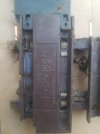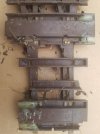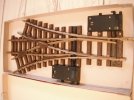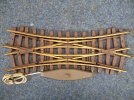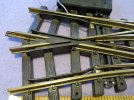Gizzy
A gentleman, a scholar, and a railway modeller....
I've mentioned on this forum that I have an LGB R3 three way point, which I believe is quite rare. (The current LGB offering is R1. I have a few of these useful space saving switches on my railway.
I brought this point many years ago on Ebay for a good price, but in those early days, I didn't realise it was R3 and 22.5 deg, so it didn't fit with my R1 points as I wanted.
I brought a 2nd hand R3 point from Adverse Camber and I used it on my first layout, before I moved.
I also used it on my current layout at Pip's Junction. However, it is showing its age, so I am relocating it to the station throat scissors crossing, replacing the current set-up using R1 points, with R3.
I've had to repair the sleeper ends where the point levers/motors attach. here's a photo or 2 of this rare beast....

I brought this point many years ago on Ebay for a good price, but in those early days, I didn't realise it was R3 and 22.5 deg, so it didn't fit with my R1 points as I wanted.
I brought a 2nd hand R3 point from Adverse Camber and I used it on my first layout, before I moved.
I also used it on my current layout at Pip's Junction. However, it is showing its age, so I am relocating it to the station throat scissors crossing, replacing the current set-up using R1 points, with R3.
I've had to repair the sleeper ends where the point levers/motors attach. here's a photo or 2 of this rare beast....

Last edited:

